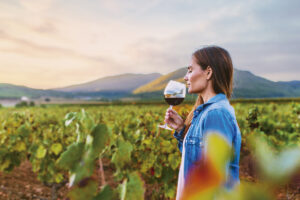
Murcia is preparing to welcome back tourists this year by placing a special focus on its many gastronomic attractions, including three outstanding wine routes. Coinciding with the decision to extend Murcia’s national “Capital of Gastronomy” status from 2020 into 2021 (due to COVID-19 restrictions last year), tourism authorities are doubling up their efforts to promote the region as an officially certified safe destination and especially highlight the healthy al fresco pleasures of wine tourism.
Murcia’s three designation of origin wine-producing areas – Bullas, Jumilla and Yecla – offer visitors the opportunity of visiting bodegas where tradition is combined with the latest wine-making technology. Tourists are invited to discover the region through its wines and enjoy an “experience of the senses” at associated bodega restaurants and museums.
The region’s excellent weather conditions, soil and other resources for grape-growing enable it to produce an extensive range of excellent reds, rosés and whites that are attracting increasing interest and popularity around the world.
Bullas
In the old town centre of Bullas there are more than 200 fully or partially preserved traditional wineries, most built between the 18th and 19th centuries. One grape variety that is inextricably linked to the land is the Monastrell (or Mourvèdre). The regulatory council guarantees its protection, limiting the use of other varieties and ensuring the quality of the wines produced.
The Wine Museum of Bullas is a must-visit. Located in one of the few wineries maintained in a perfectly preserved state since the mid-19th century, the museum houses brick vaults and partially buried jars in the ground. It once belonged to one of the richest families in the region, the Melgares de Aguilar, and today it hosts temporary exhibitions, tastings and courses.

Jumilla
One of the first areas in Spain to obtain designation of origin status for its wines, Jumilla currently is home to more than 27,400 hectares of registered vineyards. In addition to wine production, it also has a rich cultural heritage encompassing all the Mediterranean’s venerable civilisations. In 1981, Jumilla was formally designated a site of historic and artistic interest.
The most notable monument on the Jumilla wine route is its 15th century castle, constructed in 1461 by the Marquis de Villena, influenced by a mix of cultures over the centuries and today maintaining its dominating presence overlooking the town.
Yecla
Extending over 7,000 hectares of vineyards, the Yecla wine route offers visitors a diverse range of attractions and amenities including wineries, accommodation, restaurants, shops, leisure activities and wine bars. Throughout the year it hosts gastronomic festivals, tastings, oenology courses and other wine-related cultural events.
Yecla is renowned for its hearty gastronomy, with dishes such as gachamiga and gazpacho traced back to the traditional diets of Yecla peasants. Believed to be of Arab origin, gachamiga is cooked with flour, oil, garlic and water, and washed down with copious amounts of red wine. Another popular dish is fried goat’s cheese served with tomato and usually accompanied by a red or rosé wine; while fried cakes (yeast fermented sourdough fried in plenty of oil) can be eaten with sugar, salt, anchovies or honey – and served with a rosé wine.
Meatballs are generally considered to be the showpiece of Yecla’s cuisine. They are made with breadcrumbs soaked in water and milk, chopped lean meat, pine nuts, parsley and spices, boiled in the stock of a traditional stew.
